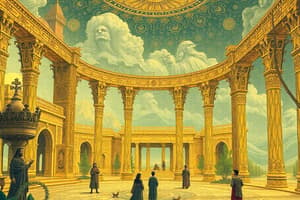Podcast
Questions and Answers
What do the mega-sequences of sedimentary rock deposits suggest about the nature of the flood?
What do the mega-sequences of sedimentary rock deposits suggest about the nature of the flood?
- They show a lack of evidence for any geological event.
- They indicate a gradual deposition process over millions of years.
- They imply that different geological periods are unrelated.
- They support the occurrence of a global event that deposited layers simultaneously. (correct)
Which sequence of rock types was identified at the bottom of the mega-sequence deposits?
Which sequence of rock types was identified at the bottom of the mega-sequence deposits?
- Claystone
- Coarse-grained sandstone (correct)
- Limestone
- Siltstone
How did the flood contribute to the formation of continents according to the mega-sequence maps?
How did the flood contribute to the formation of continents according to the mega-sequence maps?
- It caused continents to drift only slowly over time.
- It resulted in the sinking of all continental landmasses.
- It had no effect on the continental structures.
- It reconfigured continents from a supercontinent to current positions through rapid plate tectonics. (correct)
What shift in the fossil record is observed across the mega-sequences?
What shift in the fossil record is observed across the mega-sequences?
What do the massive coal deposits found globally suggest about the pre-flood world?
What do the massive coal deposits found globally suggest about the pre-flood world?
Which type of fossil evidence was primarily found in the first three mega-sequences?
Which type of fossil evidence was primarily found in the first three mega-sequences?
What does the presence of dinosaur graveyards indicate about the flood?
What does the presence of dinosaur graveyards indicate about the flood?
What is implied about the speed of plate tectonics during the flood event?
What is implied about the speed of plate tectonics during the flood event?
Flashcards
Mega-sequences
Mega-sequences
A series of distinct layers of sedimentary rock found across multiple continents, each with unique rock types.
Flood Geology
Flood Geology
The idea that a global flood event, as described in the Bible, deposited sedimentary layers on Earth.
Stratigraphy
Stratigraphy
The study of sedimentary rock layers to understand the Earth's history.
Sedimentary Deposition Sequence
Sedimentary Deposition Sequence
Signup and view all the flashcards
Continental Drift
Continental Drift
Signup and view all the flashcards
Seafloor Spreading and Subduction
Seafloor Spreading and Subduction
Signup and view all the flashcards
Fossil Record
Fossil Record
Signup and view all the flashcards
Coal Formation
Coal Formation
Signup and view all the flashcards
Study Notes
Early Civilizations
- Sumerian civilization thrived in Mesopotamia by 3000 BC, consisting of city-states.
- Cuneiform, the earliest known writing, was used on clay tablets.
- Farming and ziggurats, impressive temple towers, were central to Sumerian culture.
- Sargon established the Akkadian Empire, uniting Mesopotamian city-states.
- Amorites formed the Old Babylonian Empire, with Hammurabi's code of laws.
- They contributed to algebra, geometry, and astronomy.
- Hittites, descendants of Canaan, established an empire in Asia Minor, using iron and chariots.
- Phoenicians were skilled merchants, trading spices, purple dye, and cedar.
- They developed an alphabet using uniform symbols.
The Flood as verification of Earth's origins
- Scientific discoveries are supporting the biblical account of Noah's flood.
- Geologists identified distinct mega-sequences of sedimentary rock deposits worldwide.
- The sequences suggest a global event depositing layers simultaneously indicating a rapid process, matching a catastrophic flood.
- Mega-sequence maps show a connection between flood and continental formation.
- This involves rapid plate tectonics and ocean floor spreading, exceeding previously thought speeds.
- Fossil records show a shift from marine to land organisms, indicating rising floodwaters engulfing land.
- Coal deposits, formed from dead plant material, support the idea of a pre-flood vegetation-heavy world.
- Dinosaur graveyards suggest a catastrophic burial event.
Early Russia
- Kievan Rus grew into a powerful state controlling key trade routes, influenced by Byzantium.
- Prince Vladimir the Great's conversion to Orthodox Christianity in 988 brought significant cultural changes.
- "Russka Pravda" (Russian Justice) was a legal code.
- Political alliances, missionary work, and cultural influences led to the spread of Christianity.
- Prince Igor's death at the hands of Drevlians highlighted the power struggles in the region.
- Olga of Kiev, Igor's widow, ruled as regent, and later took revenge on the Drevlians.
The Byzantine Empire
- The Byzantine Empire preserved Roman governance, culture, and Christianity after Rome's fall.
- Empress Theodora was a powerful advisor to Emperor Justinian.
- The Great Schism (1054) divided the Eastern Orthodox Church from the Roman Catholic Church.
- The decline of the empire, including the sack of Constantinople in 1204, by Western Crusaders, eventually led to its fall in 1453.
- Preservation of classical knowledge, legal codification, art, architecture, Christianity and the Cyrillic alphabet characterize the empire.
The Roman Empire
- Rome transitioned to a republic in 509 BC, replacing the Etruscan Kings.
- The republic established a representative government with councils and elected officials like consuls and the senate.
- The Roman Republic lasted from 509 BC until 27 BC when Augustus became the first emperor.
- The Senate, composed of patricians, was a key governing body alongside other assemblies.
- The military structure played a crucial role in Roman success.
- The rise of an emperor marked the shift to the Roman Empire.
The Dark Ages, the Renaissance
- Scholasticism emerged in medieval Europe, balancing reason with faith.
- Humanism, with its focus on human potential, arose during the Renaissance.
- The English Civil Wars (1642-1651) involved Royalists and Parliamentarians.
- Martin Luther's 95 Theses challenged Church corruption, sparking the Protestant Reformation.
- The Hundred Years' War (1337-1453), between England and France, featured military advancements.
Studying That Suits You
Use AI to generate personalized quizzes and flashcards to suit your learning preferences.




